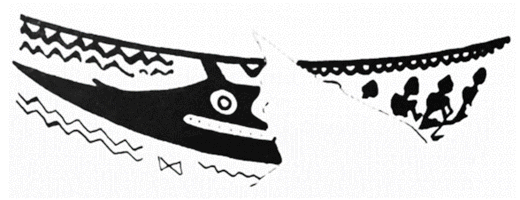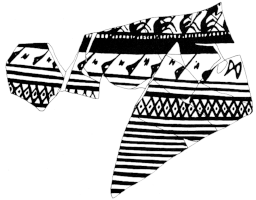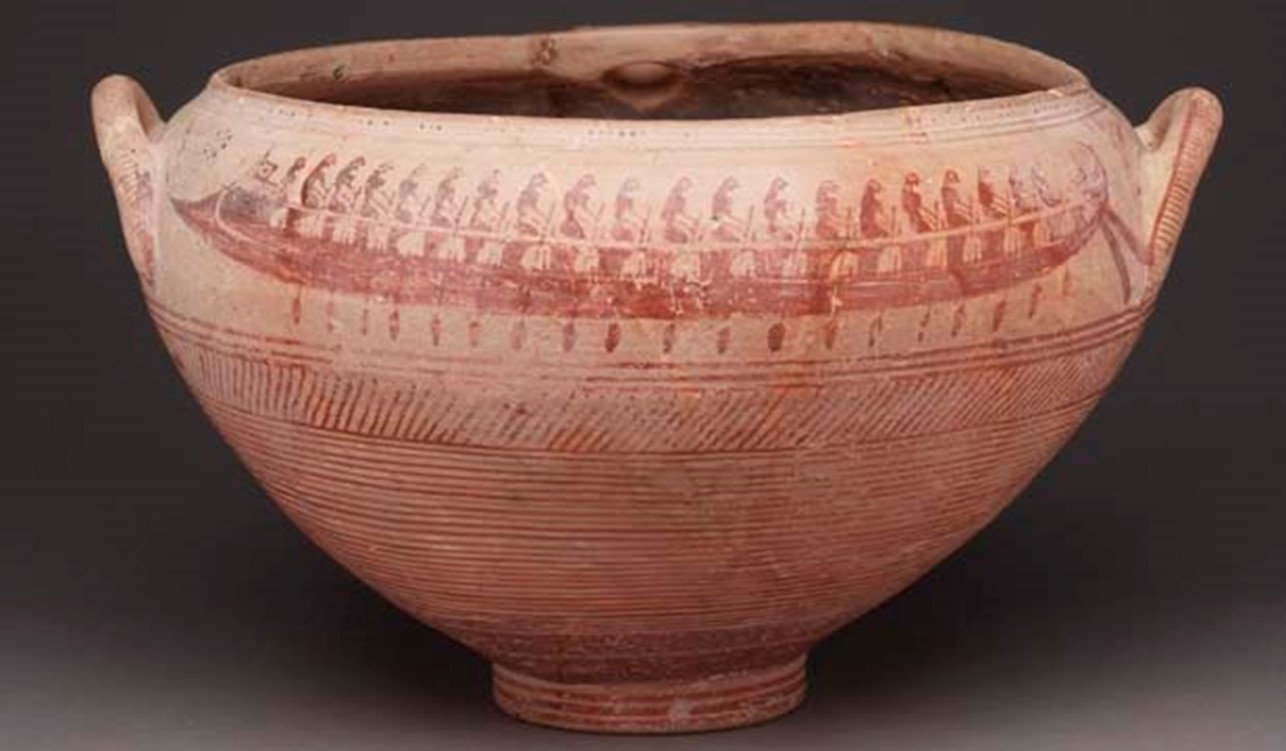Flat low hull with a concave stempost ending in a tapering pointed ram unlike the Attic type because of an almost immediate rise in the outline of the stem from the tip of the ram. Very short stem post inclined slightly forward. Bow screen decorated with an eye in the form of a circle in a reserved square, with a strip of Geometric pattern below. Running along the stem and then curving aft along the hull of the bow compartment is a reserved line. High hull silhouette with twenty-one rowing-ports. Tholepins visible inside depicted using vertical strokes. The top of the gunwale is defined by a reserved line, where nineteen oarsmen are sitting - the whole of their trunks visible - with spade-shaped blades which cross the hull and are visible over the ports. Above the gunwale is another set of tholepins for each oar. Aftercastle with an open balustrade with latticed railing. Short, plain curved stern-piece with no distinct horn except for a single projection. A single plank projects from the stem.
Two-leveled galley
A169
Protocorinthian, c. 710-700 B.C.
Thebes, Boeotia
Height: 22.8 cm; Diameter: 35.5 cm
Wide flat nozzle; cylindrical neck, convex shoulder; elongated belly; foot ring and small vertical handles. Close to work of Anatalos painter
Basch 1987: 184-87, no. 387; Hayes 1992: 33-34, no. 31 with fig. 4; Kirk 1949: 113-4, no. 38; Morrison-Williams 1968: 36, geom. 42, pl.7d; Williams 1958: 125, pl. XIVa
Horizontal fillets fill up belly half the way up, with main freeze depicting a ship on the large panel between the handles. Ship facing left, with full complement of nineteen rowers, as well as a helmsman and bow officer (prorates) depicted on a smaller scale. The rowers have rounded backs and differ from the usual Geometric portrayal of the human figure. The helmsman is grasping the looms of two large steering-oars. The painter uses two colour nuances: a dark one for the quasi totality of the image, and a light one for two reserved lines, one running along the stem and another defining the gunwale.
There is disagreement whether or not the ports along the hull with a tholepin visible in each are actually ovoid, which would be an innovation. Basch argues that on the contrary they are rectangular as on other depictions, and that this false impression is created by the right leg of the rowers which is partly visible simply blending in, thus creating a semi-circular appearance of the ports (Basch 1987: 185). The fact that the oarsmen appear above the gunwale and not behind the ports is significant. The argument that the painter placed them perched above for lack of space does not hold because of the second set of tholepins depicted at gunwale level.
This is one of the clearest, unambiguous early depictions of a two-level ship. The oars of the rowers using the upper tholepins extend into the water on the near side, thus implying they represent an upper bank. The reason for not showing the oarsmen of the lower bank is easily explained by the obvious artistic consideration that they would have obscured the ports through which their oars would have protruded. This solution of representing only the upper rowers is observable elsewhere.
There is no evidence that the artist took liberties with perspective, while the discrepancy of twenty-one oarsmen below and nineteen above further confirms this is a two-level ship (Williams 1958: 125). In order to distinguish them, the artist has separated the oars from the tholepins, although these would have been connected by straps. The lower level tholepins are at gunwale level, while the upper level rowers are seated on a raised construction with side-screens to protect the lower complement.
Basch, L. 1987. Le musée imaginaire de la marine antique. Athens: Institut Hellénique pour la preservation de la tradition nautique.
Hayes, J. W. 1992. Greek and Greek-style painted and plain pottery in the Royal Ontario Museum: excluding black-figure and red-figure vases. Toronto, Ontario: Royal Ontario Museum.
Kirk, G.S. 1949. “Ships on Geometric Vases.” BSA 44: 93-153, pls. 38-40.
Morrison, J.S. and R.T. Williams. 1968. Greek Oared Ships: 900-322 B.C. Cambridge: Cambridge University Press.
Williams, R. T. 1958. “Early Greek Ships of two levels,” JHS 78: 121-130.










